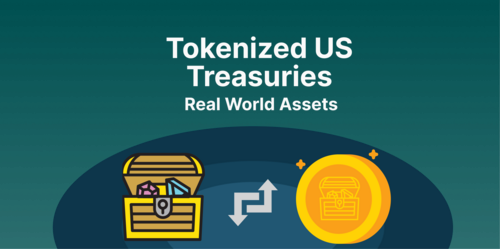Deep Dive into Tokenized Treasuries
Here, the focus is on U.S. Treasury bills and notes that have been tokenized. The module covers the technical issuance process, custody structures, compliance standards, and investor rights. It also outlines how tokenized treasuries are used in both decentralized finance (DeFi) and traditional finance (TradFi), showcasing their growing utility as stable, yield-generating instruments.
What Are Tokenized Treasuries?

Tokenized treasuries are blockchain-based representations of traditional government-issued debt instruments, such as U.S. Treasury bills (T-bills), notes, or bonds. Each token corresponds to a specific claim on the underlying treasury security, offering holders exposure to its yield and value. These digital tokens are backed one-to-one by the actual government bond, which is held in custody by a regulated financial institution or structured through a Special Purpose Vehicle (SPV).
This process allows the asset to exist in two parallel layers: the off-chain legal ownership (typically managed by the custodian or issuer) and the on-chain token that can be transferred, traded, or integrated into decentralized finance (DeFi) applications.
How Tokenized Treasuries Work
To tokenize a treasury asset, an issuer—usually a fintech firm, asset manager, or RWA (real-world asset) platform—purchases government securities and deposits them with a qualified custodian. In parallel, they issue blockchain tokens representing fractional ownership or economic rights tied to the asset. These tokens are deployed via smart contracts on public or permissioned blockchains such as Ethereum, Avalanche, or Stellar.
Investors acquire these tokens either directly from the issuer or via secondary markets. Depending on the structure, the tokens may entitle holders to receive periodic yield distributions, track the mark-to-market value of the bond, or redeem the token for fiat upon maturity. Some tokens are fixed-income bearing with scheduled payouts, while others are structured as yield-bearing stablecoin wrappers.
Economic Exposure vs. Legal Ownership
It’s important to distinguish between economic exposure and legal ownership in tokenized treasuries. In most current offerings, the blockchain token does not confer direct legal title to the treasury bond. Instead, investors gain exposure through a contractual agreement with the issuer, typically governed by off-chain terms and conditions. This is similar to how exchange-traded funds (ETFs) or money market funds operate, where the fund holds the assets and the investor holds units.
Legal clarity depends on how the product is structured and regulated. In some jurisdictions, tokens may be classified as securities and subject to investor protection rules. In others, they may function more like structured notes or synthetic exposures, raising different compliance considerations.
Blockchain Standards and Compliance Mechanisms
Tokenized treasuries are typically issued using established blockchain token standards. The most common are ERC-20 (for basic fungible tokens) and ERC-1400 or ERC-3643 (for security tokens that include transfer restrictions and identity verification). These standards allow issuers to enforce compliance directly within the smart contract, ensuring that only KYC-verified investors can hold or trade the tokens and that jurisdictional restrictions are respected.
Tokenized treasuries may also integrate with on-chain identity solutions or permissioned platforms to meet regulatory obligations. These mechanisms are essential for enabling compliant transfers and maintaining the integrity of the investor base.
Custody and Transparency
The reliability of a tokenized treasury product depends on secure custody of the underlying asset. Issuers usually partner with licensed custodians or broker-dealers to manage asset safekeeping. Some structures use trust accounts, while others rely on traditional banks or financial institutions.
Transparency is provided through regular attestations, third-party audits, or real-time proof-of-reserves published on-chain. These disclosures are vital to maintaining investor confidence, especially in cases where the token is used as collateral or yield-bearing collateral within decentralized applications.
Institutional Interest and Market Growth
As of 2025, the tokenized treasuries market has grown significantly, with over $2.5 billion in tokenized U.S. Treasuries issued across major platforms. Large institutions such as BlackRock, Franklin Templeton, Ondo Finance, and Backed Finance have entered the space, offering tokenized access to short-term government debt. These products are primarily marketed toward institutional and accredited investors, although efforts are underway to open access to a broader audience through retail-focused channels and regulatory sandboxes.
This institutional momentum signals that tokenized treasuries are not experimental concepts but emerging tools within global fixed-income portfolios.
How They Work: Technical & Legal Mechanics

The tokenization of treasuries begins with the acquisition of a traditional government security, such as a U.S. Treasury bill or note, by an entity authorized to issue digital representations. This entity can be a fintech company, asset manager, or financial institution operating under regulatory oversight. Once the bond is purchased, it is held in custody—either directly or via a Special Purpose Vehicle (SPV)—to ensure that the real-world asset is securely managed and traceable.
A blockchain-based token is then issued to represent a claim on the underlying asset. This token may be a simple economic wrapper, entitling holders to yield and redemption value, or it may be part of a more complex structure involving money market fund shares or structured financial products. The tokens are distributed through permissioned or public blockchain networks and can be bought, sold, or used in decentralized finance (DeFi) applications, depending on their design and regulatory classification.
Role of Custodians and Special Purpose Vehicles (SPVs)
Custody is a core component of trust in tokenized treasuries. The issuer must ensure that the underlying treasury instruments are stored securely, typically with a licensed custodian or under the control of a legally established SPV. The custodian is responsible for safekeeping, monitoring maturities, and executing yield payments.
In many cases, the issuer uses an SPV to hold the asset and issue digital tokens as claims against it. This structure separates the digital asset layer from the issuer’s balance sheet and limits counterparty risk in the event of insolvency. Investors’ rights are governed by contractual agreements and legal documentation that connect token ownership to the SPV’s holdings.
SPVs are also used to maintain regulatory clarity by isolating risks and ensuring proper accounting treatment of the underlying securities. In some jurisdictions, the SPV’s legal documentation explicitly defines the token holders as beneficiaries or creditors, establishing a clear claim structure.
Smart Contracts and Token Standards
The issuance and lifecycle management of tokenized treasuries are governed by smart contracts—self-executing code deployed on blockchain networks. These smart contracts define how tokens are minted, transferred, and redeemed. They also automate the distribution of yield (such as interest payments) and facilitate compliance processes such as KYC checks and transfer restrictions.
Common token standards include ERC-20 for basic fungible tokens and ERC-1400 or ERC-3643 for tokenized securities that require additional controls. These standards support programmable compliance, enabling the issuer to enforce investor whitelists, jurisdictional restrictions, and lock-up periods directly within the contract logic.
Smart contracts also support integration with price oracles to track the value of the underlying treasury instruments, allowing for real-time valuation, automated collateralization, and interaction with DeFi protocols.
Legal Framework and Investor Rights
Legal enforceability is critical to the viability of tokenized treasuries. The rights of token holders are defined through offering documents, terms of service, or subscription agreements that outline the nature of the claim. In most structures, token holders do not directly own the government security but have a contractual right to receive returns or redemptions linked to it.
These legal documents establish the framework for how income is distributed, under what conditions tokens can be redeemed, and how disputes are resolved. They also specify the roles and responsibilities of the issuer, custodian, auditor, and other third parties involved in the process.
In regulated jurisdictions, tokenized treasury products are often classified as securities, which means they are subject to financial regulation. This can include investor accreditation requirements, registration with financial authorities, and adherence to disclosure and reporting standards.
Redemption and Lifecycle Management
Tokenized treasuries typically follow a lifecycle similar to their traditional counterparts. Upon maturity of the underlying bond, the issuer redeems the token by returning the face value to holders, either in fiat or a stablecoin such as USDC. In some models, tokens are “burned” or destroyed upon redemption to reflect that the underlying asset no longer exists.
Interest or yield payments are processed either continuously (in tokenized form) or at fixed intervals, depending on how the smart contract is configured. These payments are often distributed to wallet addresses holding the token, eliminating the need for manual dividend processing or third-party payment agents.
For open-ended structures, such as money market funds or rolling T-bill portfolios, tokens may be redeemable at net asset value (NAV) on demand, subject to liquidity constraints and operational limits imposed by the issuer.
Compliance Infrastructure
Given that most tokenized treasuries fall under security classifications, robust compliance infrastructure is essential. This includes KYC/AML procedures, identity verification, and ongoing monitoring of investor eligibility. Platforms may use third-party compliance providers or build in-house solutions that integrate directly with the blockchain to enforce these checks on-chain.
Whitelisting mechanisms ensure that only verified users can interact with the token. Transfers can be restricted to wallets that meet regulatory criteria, and automated compliance rules can be updated in response to changes in law or investor status.
Regulatory compliance is one of the primary bottlenecks to broader adoption. However, the emergence of programmable compliance frameworks on blockchain networks has made it increasingly viable to issue and manage these instruments in a legally compliant manner.
Use Cases in DeFi and TradFi
Tokenized treasuries have found immediate application within the DeFi ecosystem, where they serve as yield-bearing instruments and collateral in lending, trading, and stablecoin protocols. These tokens represent real-world, low-risk government assets, making them attractive for use in applications traditionally dependent on volatile crypto-native assets.
In lending platforms, tokenized treasuries can be used as overcollateralized assets to secure loans, similar to how ETH or stablecoins function in existing protocols. This allows users to access liquidity without selling their positions, while simultaneously earning interest from the underlying bond. Some protocols are exploring undercollateralized lending models using tokenized treasuries to back institutional borrowers, offering more efficient capital deployment with lower default risk.
Decentralized asset management platforms also utilize tokenized treasuries as part of diversified yield strategies. Smart contract vaults can combine stablecoin liquidity with tokenized treasury exposure to offer risk-adjusted returns that balance on-chain yield with off-chain stability. This has opened the door for more conservative investors to participate in DeFi without taking on high levels of volatility.
Additionally, tokenized treasuries are being incorporated into liquidity pools and automated market makers (AMMs) to improve the capital efficiency of stable swaps. Some protocols use them as interest-bearing base layers for algorithmic stablecoins, enabling more predictable backing models.
Applications in Traditional Finance (TradFi)
In traditional financial markets, tokenized treasuries are being adopted by institutions as a more efficient way to access government debt. Asset managers, family offices, and corporate treasuries use them to maintain short-term liquidity positions while benefiting from operational improvements such as faster settlement and improved transparency.
Tokenized versions of T-bills and money market funds enable firms to move capital more efficiently across global entities. For example, a multinational business may use tokenized treasuries to shift idle capital into U.S. debt instruments without relying on traditional banks or delayed settlement infrastructure. These digital assets provide both yield and flexibility in treasury management, especially for entities operating across time zones and currencies.
Furthermore, broker-dealers and fintech platforms are using tokenized treasuries to offer on-chain savings products to end users. By packaging U.S. government exposure into regulated digital tokens, platforms can create dollar-denominated investment offerings that are accessible to users worldwide—even those without traditional brokerage accounts.
Institutional trading desks also benefit from intraday liquidity and programmability. Tokenized treasuries can be integrated into smart contract-based clearing systems, reducing reconciliation workloads and improving real-time position tracking.
Bridging DeFi and TradFi Through Composability
Perhaps the most important use case lies in the convergence of DeFi and TradFi. Tokenized treasuries act as a bridge between these domains, allowing traditional assets to be used within programmable financial systems. Institutional investors gain the benefits of blockchain—speed, automation, and global reach—without abandoning their exposure to regulated, low-risk instruments.
The composability of tokenized treasuries means they can be embedded into DeFi protocols, structured products, and digital wallets with minimal friction. This has implications for neobanks, stablecoin issuers, and cross-border payment platforms seeking secure, yield-bearing assets that can operate at internet speed.
Through this hybrid use, tokenized treasuries help to normalize blockchain in traditional finance while enhancing the maturity of on-chain applications by bringing stable, real-world value into the system.





